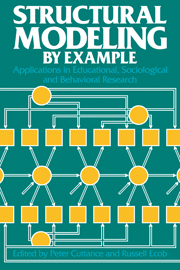Book contents
- Frontmatter
- Contents
- Preface
- List of contributors
- 1 Introduction
- 2 An overview of structural equation modeling
- 3 Field dependence and the differentiation of neurotic syndromes
- 4 High school seniors' reports of parental socioeconomic status: black–white differences
- 5 Modeling the hierarchical structure of learning
- 6 A study of longitudinal causal models comparing gain score analysis with structural equation approaches
- 7 Some structural equation models of sibling resemblance in educational attainment and occupational status
- 8 Applications of structural equation modeling to longitudinal educational data
- 9 The robustness of maximum likelihood estimation in structural equation models
- 10 An inquiry into the effects of outliers on estimates of a structural equation model of basic skills assessment
- 11 Testing structural equation models
- 12 LISREL models for inequality constraints in factor and regression analysis
- 13 Issues and problems in the application of structural equation models
- Appendix
- Glossary
- Index
5 - Modeling the hierarchical structure of learning
Published online by Cambridge University Press: 12 January 2010
- Frontmatter
- Contents
- Preface
- List of contributors
- 1 Introduction
- 2 An overview of structural equation modeling
- 3 Field dependence and the differentiation of neurotic syndromes
- 4 High school seniors' reports of parental socioeconomic status: black–white differences
- 5 Modeling the hierarchical structure of learning
- 6 A study of longitudinal causal models comparing gain score analysis with structural equation approaches
- 7 Some structural equation models of sibling resemblance in educational attainment and occupational status
- 8 Applications of structural equation modeling to longitudinal educational data
- 9 The robustness of maximum likelihood estimation in structural equation models
- 10 An inquiry into the effects of outliers on estimates of a structural equation model of basic skills assessment
- 11 Testing structural equation models
- 12 LISREL models for inequality constraints in factor and regression analysis
- 13 Issues and problems in the application of structural equation models
- Appendix
- Glossary
- Index
Summary
Introduction
In the social and behavioral sciences, theories abound that view phenomena as hierarchically organized and decomposable into entities that can be ordered in terms of their complexity. For example, learning has frequently been conceptualized as a hierarchy of processes or outcomes of increasing complexity. Of particular importance to educators because of the impact they have had on curriculum and test development are a number of educational taxonomies – taxonomies being, of course, a type of theory – that embody the notion of a hierarchy of processes or outcomes (Bloom et al. 1956; Gagne 1975; Ausubel & Robinson 1969; Merrill 1971; Biggs & Collis 1981).
This chapter illustrates how theories involving the notion of a hierarchy of variables of increasing complexity can be expressed in mathematical form as a series of structural models and how the analysis of empirical data using these models can be employed to reformulate the original theories.
Modeling hierarchical structure: the Guttman simplex model
One of the most significant attempts to express the concept of a hierarchy of variables of increasing complexity in mathematical form was that of Guttman (1954), who proposed a theory to explain the pattern of intercorrelations to be observed among mental test scores. Guttman proposed (pp. 260–1) that, if content is held constant, a set of tests will differ only in terms of their complexity and are said to belong to a “simplex,” since they can be arranged in rank order from least to most complex.
In translating the concept of the simplex into mathematical terms, Guttman considered the case of continuous variables.
- Type
- Chapter
- Information
- Structural Modeling by ExampleApplications in Educational, Sociological, and Behavioral Research, pp. 65 - 85Publisher: Cambridge University PressPrint publication year: 1988
- 1
- Cited by

